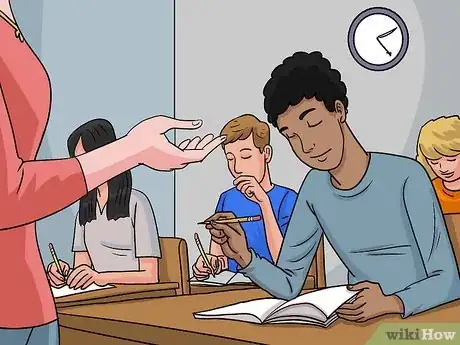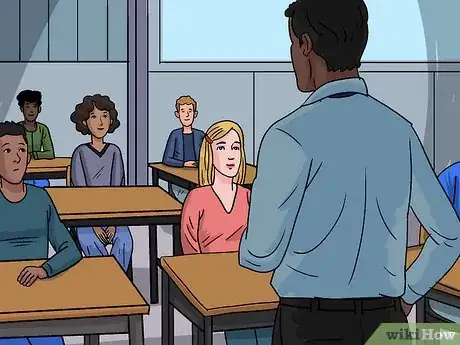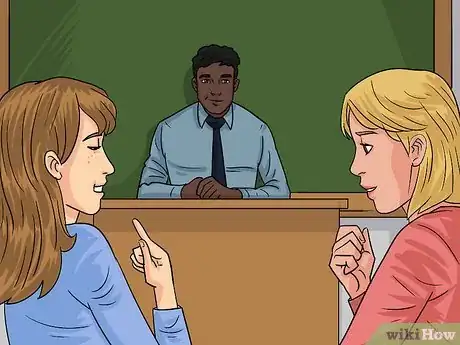This article was co-authored by Jai Flicker. Jai Flicker is an Academic Tutor and the CEO and Founder of Lifeworks Learning Center, a San Francisco Bay Area-based business focused on providing tutoring, parental support, test preparation, college essay writing help, and psychoeducational evaluations to help students transform their attitude toward learning. Jai has over 20 years of experience in the education management industry. He holds a BA in Philosophy from the University of California, San Diego.
There are 14 references cited in this article, which can be found at the bottom of the page.
This article has been viewed 44,253 times.
Teaching middle school students can pose a particular challenge for teachers. Your students are caught in a strange developmental phase -- they are no longer children but they also cannot take on the responsibilities of an older teen or young adult. Understanding the needs of the early adolescent brain can help you present your material so it meets the standards of your school but also fulfills the learning needs of your students.
Steps
Communicating with Middle School Students
-
1Divide your lesson into chunks. Research has shown that middle schoolers learn best when their lessons are divided in 7-10 minute chunks of different activities. Lessons should be a combination of learning from lecture and processing activities.[1]
- A processing activity is one in which students must manipulate information or relate the information to something they already know. This might be an activity like writing an alternate ending to a story they have read, conducting a lab experiment, or participating in a debate with their fellow classmates.[2]
-
2Limit the amount of lecture. Studies show that middle school students can only handle 10-12 minutes of direct instruction (or lecture). After 10-12 minutes, their brains begin to filter out information of the lecture and turn to other thoughts. While lecture is an important component of teaching, you need to supplement it with processing activities.[3]
- If you are giving a lecture, be sure to present it in an engaging way. Don't just read off of a worksheet or set of notecards. Read as if you are telling a story.
- Be sure to make eye contact with your students as you are presenting the material. Make sure they know that you are speaking directly to them because you want them to understand the material.
Advertisement -
3Teach with visuals. Research has shown that middle school students respond most positively to visual images when they process information. Visual images give students concrete, easily digestible information as opposed to abstract information (which they won't be able to grapple with until they are 18-20 years old).[4]
- Dynamic visuals -- or visuals that move as opposed to remaining static -- have been shown to have the most significant impact on students. Look for charts that have moving elements, films, or a series of interactive images as opposed to just one or two static images.
- You should also consider using manipulatives, which are physical objects that students can touch in order to learn material from the lesson. They are commonly used in math (such as using blocks to teach geometry), but you might also consider using objects in other areas, like bringing in an old copy of a magazine from the 1930s if you are teaching history.
-
4Build your lessons around your student's voices. Middle school students need to interact with information directly in order to fully understand it. They no longer view you, as the teacher, as a fount of knowledge; they need to form opinions about the material on their own.
- Incorporate the Think-Pair-Share method. When you are teaching a particular lesson, ask the students a question about the material. Have them write down a response to the question and then share their ideas with a partner. Then, as a class, discuss your responses out loud.[5]
-
5Value your student's emotions. As middle schoolers, most students will relate to the world around them emotionally rather than through logic or reason. As you teach your material, be sure to present it in terms of its emotional impact.[6]
- The extent to which you can do this in each discipline will vary. But you should incorporate methods such as storytelling into appropriate disciplines like English, social studies and even subjects like science and mathematics.
- Humor is also a key element in connecting with your students emotionally. Make sure your jokes are appropriate and avoid anything bordering on snark or sarcasm.
-
6Keep your lesson plans diverse.[7] Above all, make sure your lessons incorporate a wide variety of activities. Ask your students to take notes, write reflection pieces, work in groups, conduct investigations and play games. This will prevent boredom and help your students develop a broad range of cognitive skills.[8]
- Be sure to incorporate activities that require memorization and repetition on the part of your students. This is a valuable skill that still needs development in the brain at this age. You can use flash cards, rhyming games or simply ask students to repeat vital pieces of information out loud to practice this. [9]
-
7Build in time for reflection. Encouraging time for your students to write in a journal about what they have learned or how they experienced the lesson for the day will help them see the broader goals of the class [10]
-
8Ask "Why" as much as possible. Encouraging your students to come up with their own opinions will help them build solid critical thinking skills.[11]
Providing Additional Support to Your Students
-
1Maintain consistent rules in the classroom. Young adolescents might begin to test the boundaries of authority, but they still need a clear set of rules and boundaries in order to learn.[12]
- On the first day of class, include your students in the creation of the rules and make sure they understand why they need to be in place. If one of your rules is to respect each other, you should ask your students what this would entail (for instance, taking turns when talking as opposed to speaking over each other).[13]
- Establish regular routines in your class so your students know what to expect. For instance, you might start each day with an inspirational quote or story relating to your lesson for the day. You can use this routine to warm up discussion amongst your students.[14]
- Giving your students a syllabus will also help them develop their abilities to plan and organize their study schedules. A syllabus should include the dates of the classes, what you plan to teach on each date, and any reading or assignments that your students should complete before attending that class.
-
2Be aware of social aggression in your classroom. In middle school, students often start to form deep friendships and social hierarchies. Students can be harassed or ostracized for things ranging to their appearance to their the race, sexuality or religion. Be sure to look out for this toxic behavior and shut it down whenever you see it occurring between students in your classroom.[15]
- If a student is acting in a disruptive or disrespectful manner in class, then pull them aside (either after class or at a natural lull in the lesson, like when students begin to work independently), to talk with them. Do not express frustration with them but rather, empathy. Say, "I noticed that you are having trouble focusing on the assignment. What can I do to help you?" The student might not respond well to a scolding but they will respond to a question that asks them to reflect on their actions and ask for help.[16]
- Discuss bullying directly with your students. Have them study its damaging effects and ask them to explain why they must avoid hurting their fellow students.
- Talk to your administrators about implementing a zero tolerance policy toward bullying at your school. Familiarize yourself with any district policies on bullying or disruptive behavior in the classroom.
-
3Monitor your students' physical health. The adolescent brain and body needs 10 hours of sleep in order to fully develop. If you have students who consistently struggle to remain awake and complete their work, then you should notify their parents about your concerns. There might be a larger medical problem involved.[17]
- Encourage your students to drink water. The pre-adolescent brain needs to be well hydrated in order to develop. Encourage your students to drink water in class and at lunch.[18]
Understanding the Middle School Student's Brain
-
1Be patient with your student's mental development. Between the ages of 11 and 13, students are juggling a huge range of physical and psychological changes. In addition to the increase of hormonal production in the body, they are also dealing with the delayed development of the neo-cortex. [19]
- The neo-cortex is a frontal lobe in the brain that handles executive processes such as making plans, setting goals, and thinking of long term consequences. This part of the brain is the last to develop and is often not fully functioning in early adolescent students.
- Until the neo-cortex is developed, the brain processes language through the amygdala, or the emotional part of the brain. This is why adolescents often make impulsive decisions based on emotion rather than reason.[20]
-
2Learn about stress and your student's brain. The increased production of hormones in the early adolescent's body enacts a number of changes on your students. But one change that might be overlooked is an increased sensitivity to stress.[21]
- In particular, your students may become stressed by the physical changes in their body, such as the awkwardness of a growth spurt or the development of breasts, pubic hair, facial hair, etc. These changes can make your students feel like they have lost control over their own bodies.
-
3Forgive your student's selfishness. The early adolescent brain is still developing its social development functions. That means that your students will often be most concerned with themselves first and foremost.
- Early adolescence is a period where students will need to practice moral reasoning in order to develop empathy and compassion.[22]
Community Q&A
-
QuestionWhat do I do about students that exhibit sexual behavior towards their teachers?
 Community AnswerYou should talk to their parents about this, as this is not acceptable. Talking to the student is a difficult approach, so schedule a meeting with the parent(s).
Community AnswerYou should talk to their parents about this, as this is not acceptable. Talking to the student is a difficult approach, so schedule a meeting with the parent(s). -
QuestionI am a high schooler and I volunteered for teaching middle schoolers for a few days, but they’re not taking me seriously, how do maintain discipline in the class?
 AbigailMillerCommunity AnswerFirst, you need to understand the school's guidelines regarding disciplinary procedures. Second, treat students fairly, positively, and consistently. And provide a list of standards and consequences to parents and students.
AbigailMillerCommunity AnswerFirst, you need to understand the school's guidelines regarding disciplinary procedures. Second, treat students fairly, positively, and consistently. And provide a list of standards and consequences to parents and students.
References
- ↑ http://www.nea.org/tools/16708.htm
- ↑ http://www.nea.org/tools/16708.htm
- ↑ https://www.naesp.org/resources/2/Middle_Matters/2009/MM2009v17n4a2.pdf
- ↑ https://onlinelibrary.wiley.com/doi/abs/10.1002/tea.21003
- ↑ http://spots.wustl.edu/SPOTS%20manual%20Final/SPOTS%20Manual%204%20Learning%20Strategies.pdf
- ↑ http://www.nea.org/tools/16708.htm
- ↑ Jai Flicker. Academic Tutor. Expert Interview. 20 May 2020.
- ↑ http://undsci.berkeley.edu/teaching/68_implications.php
- ↑ http://spots.wustl.edu/SPOTS%20manual%20Final/SPOTS%20Manual%204%20Learning%20Strategies.pdf
- ↑ http://civics.sites.unc.edu/files/2012/05/managingtheMSclassroom.pdf
- ↑ Jai Flicker. Academic Tutor. Expert Interview. 20 May 2020.
- ↑ http://www.nea.org/tools/15377.htm
- ↑ http://civics.sites.unc.edu/files/2012/05/managingtheMSclassroom.pdf
- ↑ http://www.edutopia.org/blog/art-of-managing-middle-schoolers-ben-johnson
- ↑ http://www.stopbullying.gov/prevention/at-school/build-safe-environment/
- ↑ http://civics.sites.unc.edu/files/2012/05/managingtheMSclassroom.pdf
- ↑ https://www.naesp.org/resources/2/Middle_Matters/2009/MM2009v17n4a2.pdf
- ↑ https://www.naesp.org/resources/2/Middle_Matters/2009/MM2009v17n4a2.pdf
- ↑ http://spots.wustl.edu/SPOTS%20manual%20Final/SPOTS%20Manual%204%20Learning%20Strategies.pdf
- ↑ http://spots.wustl.edu/SPOTS%20manual%20Final/SPOTS%20Manual%204%20Learning%20Strategies.pdf
- ↑ http://www.nimh.nih.gov/health/publications/the-teen-brain-still-under-construction/index.shtml?utm_source=LifeSiteNews.com+Daily+Newsletter&utm_campaign=2c0fa9560b-LifeSiteNews_com_Intl_Full_Text_12_18_2012
- ↑ http://www.ncbi.nlm.nih.gov/pubmed/7484353




















-Step-15.webp)





















































